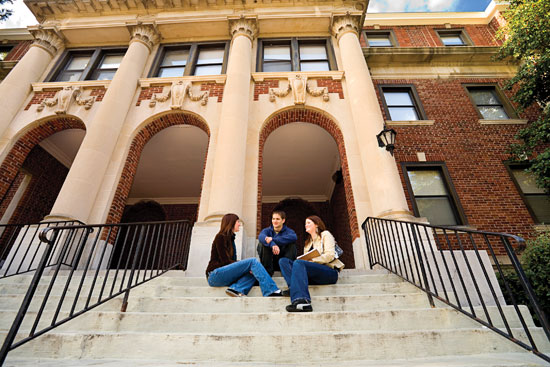State cuts put colleges in precarious situation
The nation's 28 veterinary colleges have been hit hard by steep reductions in state appropriations to higher education, leading to cuts in faculty, substantial tuition increases, and increased student debt, according to new data from the Association of American Veterinary Medical Colleges.
Findings from the 2012 AAVMC Advocacy Survey were presented during a closed-door economic summit attended by AVMA and veterinary college officials this January in Orlando, Fla.

Results of the AAVMC survey show an 84 percent increase in median out-of-state veterinary tuition over a 10-year period, from $21,100 in 2000-2001 to $38,788 in 2010-2011. Median in-state tuition jumped 101 percent in that same time, from $9,134 to $18,316. In total, tuition revenue at the 28 veterinary institutions has more than doubled, going from $4 million in 2001-2002 to $8.7 million in 2011-2012.
Separate figures for Ross University in St. Kitts and St. George's University in Grenada place tuition at about $30,000 and $32,000, respectively, for two semesters.
As for student enrollment, the AAVMC projects a 3.7 percent increase at U.S. veterinary colleges, from 11,255 for the 2011-2012 school year to 11,677 for the 2012-2013 school year. It would be the second largest bump in a decade with the greatest increase coming from an addition of 512 students (a 4.9 percent increase) between 2008-2009 and 2009-2010. In the past 10 years, U.S. veterinary colleges will have added 2,314 seats, which is almost a 25 percent increase from total enrollment of 9,363 students for the 2002-2003 school year. Adding the two Caribbean veterinary colleges would increase the total enrollment for the 2012-2013 school year by about 1,500 more students.
Dr. Gerhardt G. Schurig, AAVMC president and dean of the Virginia-Maryland Regional College of Veterinary Medicine, said in an AAVMC press release that even though tuition has gone up, the extra revenue barely begins to make up for more than $106 million in cuts in just the past two years, when total state appropriations for U.S. veterinary colleges dropped from $642 million to $536 million. In the past decade, student aid—that is, anything from scholarships to endowments to private donations—per DVM/VMD student has risen only 42 percent, from $2,371 in 2001 to $3,375 in 2011.
"These are challenging times for veterinary medical education and higher education in general. What's particularly alarming is how schools report that this is affecting their ability to hire and maintain faculty and provide students with the course offerings that they need," Dr. Schurig said in the release.
According to the AAVMC Advocacy Survey, which received response from all but two U.S. veterinary colleges, more than half of respondents reported that cuts in state support for academic veterinary medicine, particularly over the past couple years, have seriously affected their ability to hire or retain faculty and staff, invest in new technology, maintain academic programs and course offerings, or provide extension and outreach services. Twenty-two veterinary colleges said state funding cuts have reduced their ability to update or maintain campus infrastructure.
These are challenging times for veterinary medical education and higher education in general. What's particularly alarming is how schools report that this is affecting their ability to hire and maintain faculty and provide students with the course offerings that they need.
Dr. Gerhardt G. Schurig, AAVMC president
"I think we need to fight to sustain and garner public support, but we will also have to start looking at alternative funding sources and educational models if we want to maintain quality," Dr. Schurig said in the release. "We also need to work with other stakeholders of academic veterinary medicine to find ways to increase student financial aid."
Dr. Schurig and nearly 70 other leaders representing all 28 U.S. veterinary colleges and seven foreign AVMA Council on Education–accredited colleges, the AAVMC, and the AVMA, met Jan. 15 in Orlando for the joint economic summit. The goal was to start a dialogue among the stakeholders and commit to working together on behalf of the broader profession. Attendees identified a range of economic issues and pressures they agreed were critical to the veterinary profession. They also determined that workforce concerns, educational debt, demand for clinical veterinary services, and public support of veterinary education were of high priority.
AVMA President-elect Douglas G. Aspros called the meeting a valuable and productive first step. "All of us came away from the meeting with a sense of relief that we got so many things out on the table and walked out of the room united as a profession," he said.
The need to find and develop data sets on the demand for veterinary services that everyone can agree on became apparent at the meeting, he added, noting that such data sets currently don't exist.
"If we want to talk about solutions for veterinary medicine, we need to guide education and professional development with reliable and contemporary data." The AVMA is already working in this area with the recent appointment of members to the Veterinary Economics Strategy Committee (see article) and with development under way on a Veterinary Economics Division within the AVMA.
Going forward, summit participants agreed to jointly review the anticipated National Academy of Sciences veterinary workforce study, when released, and committed to participating in additional meetings. The first will occur during the AAVMC's annual conference March 8-11 in Alexandria, Va., and will focus on identifying specific economic solutions. Progress reports will be jointly released periodically to AVMA and AAVMC members, and working committees could be established.
Correction: Tuition, student aid, and enrollment percentages have been corrected.